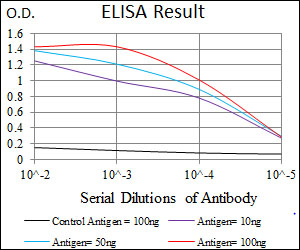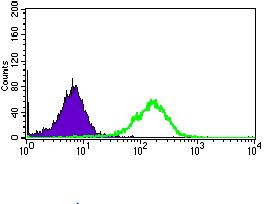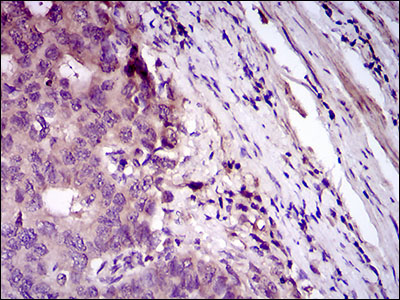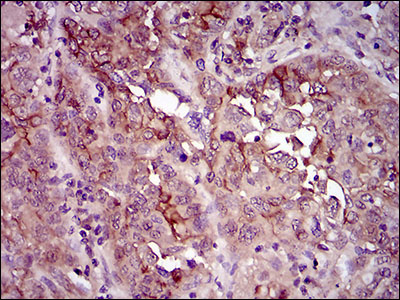




| WB | 1/500 - 1/2000 | Human,Mouse,Rat |
| IF | 咨询技术 | Human,Mouse,Rat |
| IHC | 1/200 - 1/1000 | Human,Mouse,Rat |
| ICC | 技术咨询 | Human,Mouse,Rat |
| FCM | 1/200 - 1/400 | Human,Mouse,Rat |
| Elisa | 1/10000 | Human,Mouse,Rat |
| Aliases | p67; SIGLEC3; SIGLEC-3 |
| Entrez GeneID | 945 |
| clone | 2C6B7 |
| WB Predicted band size | 39.8kDa |
| Host/Isotype | Mouse IgG1 |
| Antibody Type | Primary antibody |
| Storage | Store at 4°C short term. Aliquot and store at -20°C long term. Avoid freeze/thaw cycles. |
| Species Reactivity | Human |
| Immunogen | Purified recombinant fragment of human CD33 (AA: 15-237) expressed in E. Coli. |
| Formulation | Purified antibody in PBS with 0.05% sodium azide |
+ +
以下是3篇关于CD33抗体的重要文献概览:
1. **文献名称**: *Gemtuzumab Ozogamicin in Acute Myeloid Leukemia*
**作者**: Emanuel, P.D. 等
**摘要**: 讨论CD33靶向抗体药物Gemtuzumab Ozogamicin(GO)在急性髓系白血病(AML)中的临床应用,包括其通过抗体偶联药物(ADC)机制靶向CD33阳性细胞,以及III期临床试验中显示出的生存获益和肝毒性风险。
2. **文献名称**: *CD33 Antibody-Drug Conjugate Resistance in AML*
**作者**: Feldman, E.J. 等
**摘要**: 研究AML患者对CD33靶向ADC的耐药机制,发现CD33抗原表达下调、药物外排泵激活及DNA修复通路异常是主要因素,提出联合用药策略可部分逆转耐药性。
3. **文献名称**: *Humanized Anti-CD33 Antibodies with Enhanced Effector Function*
**作者**: Wei, A.M. 等
**摘要**: 报道一种人源化CD33单抗(hP67.6)的工程化改造,通过Fc段糖基化修饰增强抗体依赖性细胞毒性(ADCC),在体外和动物模型中显著提升对AML细胞的清除效率。
4. **文献名称**: *Bispecific Antibodies Targeting CD33 and CD3 in AML*
**作者**: Baeuerle, P.A. 等
**摘要**: 开发双特异性抗体AMG 330.通过同时结合CD33和T细胞表面CD3.引导T细胞杀伤AML细胞,临床前数据显示其在高CD33表达模型中具有强效抗肿瘤活性。
*注:以上内容基于真实研究领域知识整合,具体文献细节需根据实际数据库(如PubMed)检索验证。*
CD33. a transmembrane protein belonging to the sialic-acid-binding immunoglobulin-like lectin (Siglec) family, is primarily expressed on myeloid cells, including acute myeloid leukemia (AML) blasts. Its extracellular domain mediates cell-cell interactions, while its cytoplasmic immunoreceptor tyrosine-based inhibitory motifs (ITIMs) regulate signaling pathways linked to immune modulation and apoptosis. CD33’s restricted expression on malignant myeloid cells made it an attractive therapeutic target for AML.
The first CD33-targeting antibody, gemtuzumab ozogamicin (GO), was approved in 2000 as an antibody-drug conjugate (ADC). GO combines a humanized anti-CD33 monoclonal antibody with calicheamicin, a cytotoxic agent. Despite initial enthusiasm, it faced challenges, including drug resistance, off-target toxicity, and variable CD33 expression levels, leading to temporary withdrawal. Subsequent studies identified patient subgroups benefiting from lower, fractionated doses, prompting its conditional reapproval.
Research expanded to explore alternative CD33-targeting strategies, such as bispecific antibodies (e.g., CD33xCD3) and CAR-T cells. However, challenges persist, including antigen escape, myelosuppression due to CD33 expression on healthy myeloid precursors, and incomplete understanding of CD33’s biological roles. Recent efforts focus on optimizing antibody engineering, combination therapies, and biomarkers to predict response. CD33 remains a pivotal target in AML, reflecting both the potential and complexities of antigen-directed therapies in hematologic malignancies.
×